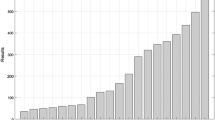Abstract
Marginal rates and elasticities of substitution are derived from the optimal slack values obtained from modified versions of additive DEA models. Projection formulas are used to ensure that all points are on the efficient frontier as required for conformance with assumptions in micro-economics. The models used differ from standard versions in that slack values are allowed to be negative as well as positive in these additive models. This makes movement possible on efficiency frontiers, where improvement in some inputs or outputs requires worsening other inputs or outputs. A new definition is therefore introduced in which efficiency is attained only if the value of the worsenings is exactly offset by the value of the improvements. This includes, but is not restricted to, the case in which all slacks must be zero for full attainment of efficiency—as in standard versions of additive models.
Similar content being viewed by others
References
Ali, I., and L. M. Seiford. (1990). “Translation Invariance in Data Envelopment Analysis.” Operations Research Letters 9, 403-405.
Bardhan, I., W. F. Bowlin, W. W. Cooper, and T. Sueyoshi. (1996). “Part I: Models and Measures for Efficiency Evaluation in DEA. Part II: Free Disposal Hulls and MED Measures.” Journal of the Operational Research Society of Japan 39, 322-332 and 333-344.
Blackorby, M., and R. Russell. (1989). “Will the Real Elasticity of Substitution Please Stand Up? A Comparison of Allen-Uzawa and Morishima Elasticities.” The American Economic Review, 882-888.
Charnes, A., andW.W. Cooper. (1961). Management Models and Industrial Applications of Linear Programming. New York: John Wiley & Sons, Inc.
Charnes, A., W. W. Cooper, B. Golany, L. Seiford, and J. Stutz. (1985a). “Foundation of Data Envelopment Analysis for Pareto-Koopmans Efficient Empirical Production Functions.” Journal of Econometrics 30, 91- 107.
Charnes, A., W. W. Cooper, A. Y. Lewin, R. C. Morey, and J. Rousseau. (1985b). “Sensitivity and Stability Analysis in DEA.” Annals of Operations Research 2, 139-156.
Charnes, A., W. W. Cooper, and E. Rhodes. (1978). “Measuring the Efficiency of Decision Making Units.” European Journal of Operational Research 2, 429-444.
Coelli, T., D. S. P. Rao, and G. E. Battese. (1998). An Introduction to Efficiency and Productivity Analysis. Norwell, Mass: Kluwer Academic Publishers.
Cooper, W. W., K. S. Park, and J. T. Pastor. (1999). “RAM: A Range Adjusted Measure of Inefficiency for Use with Additive Models, and Relations to Other Models and Measures in DEA.” Journal of Productivity Analysis 11, 5-42.
Cooper, W. W., L. M. Seiford, and K. Tone. (1999). Data Envelopment Analysis. A Comprehensive Text with Models, Applications, References and DEA-Solver Software. Boston: Kluwer Academic Publishers.
Färe, R., S. Grosskopf, and C. A. K. Lovell. (1994). Production Frontiers. Cambridge: Cambridge University Press.
Färe, R., S. Grosskopf, and C. A. K. Lovell. (1985). The Measurement of Efficiency of Production. Boston: Kluwer-Nijhoff Publishing Co.
Farrell, M. J. (1957). “The Measurement of Productive Efficiency,” Journal of the Royal Statistical Society, Series A 120, 253-290.
Gass, S. I., and C. M. Harris, eds. (1996). Encyclopedia of Operations Research and Management Science. Boston: Kluwer Academic Publisher.
Hackman, S. T., U. Passy, and L. K. Platzman (1994). “Explicit Representation of the Two-Dimensional Section of a Production Possibility Set.” Journal of Productivity Analysis 5, 161-170.
Kozmetsky, G., F. Phillips, and S. Thore. (1994). “DEA of Financial Statements: The U.S. Computer Industry.” The Journal of Productivity Analysis 2, 229-248.
Nemhauser, G. L., A. H. G. Rinooy Kan, and M. J. Todd. (1989). Optimization-Volume 1 in Handbook of Operations Research and Management Science Series. Amsterdan, North Holland, Inc.
Neralic, L. (1997). “Sensitivity in Data Envelopment Analysis for Arbitrary Perturbations of Data.” Glasnik Matematicki 32, 315-335.
Pastor, J. T. “Translation Invariance in DEA: A Generalization.” Annals of Operations Research 66, 93-102.
Rosen, D., C. Schaffnit, and S. C. Paradi. (1998). “Marginal Rates and Two-Dimensional Level Curves in DEA.” Journal of Productivity Analysis 9, 205-232.
Thore, S. (1999). “Enterprise in the Information Age.” In W. E. Halal and K. B. Taylor (eds.), Twenty First Century Economics. New York: St. Martin's Press.
Thrall, R. M. (1999). “Measures in DEA with an Application to the Malmquist Index.” Journal of Productivity Analysis, this issue.
Varian, H. R. (1984). Microeconomic Analysis. New York: W. W. Norton Co.
Wendell, R. E. (1982). “A Preview of a Tolerance Approach to Sensitivity Analysis in Linear Programming.” Discrete Mathematics 38, 121-124.
Wendell, R. E. (1985). “The Tolerance Approach to Sensitivity Analysis in Linear Programming.” Management Science 31, 564-578.
Author information
Authors and Affiliations
Rights and permissions
About this article
Cite this article
Cooper, W.W., Park, D.K.S. & Ciurana, P.J.T.P. Marginal Rates and Elasticities of Substitution with Additive Models in DEA. Journal of Productivity Analysis 13, 105–123 (2000). https://doi.org/10.1023/A:1007896629828
Issue Date:
DOI: https://doi.org/10.1023/A:1007896629828




